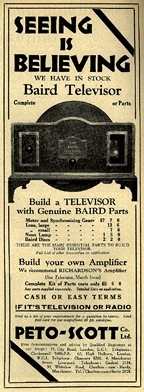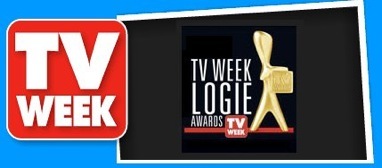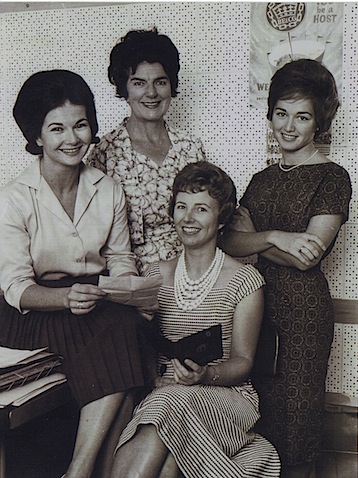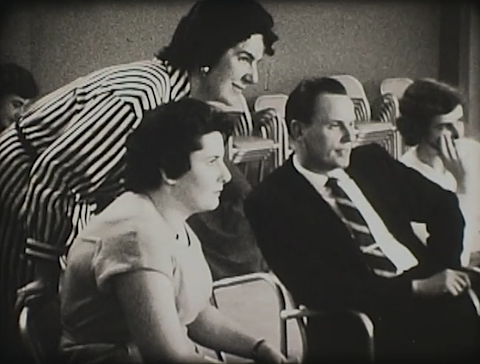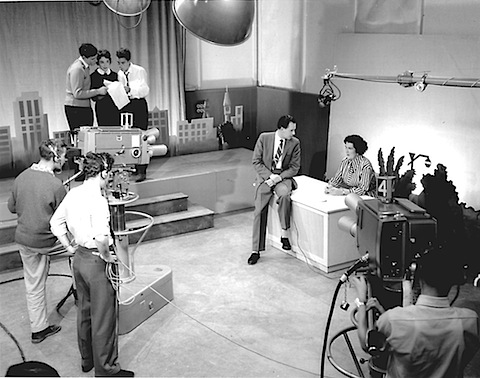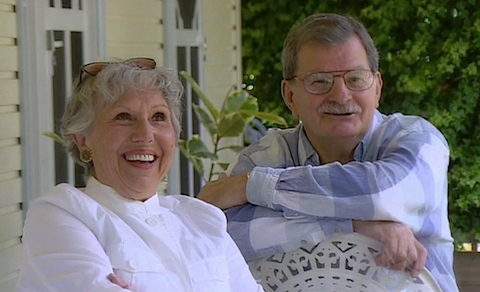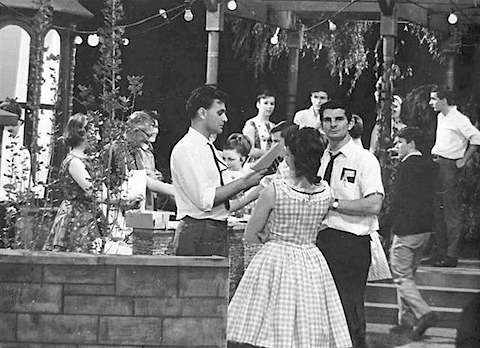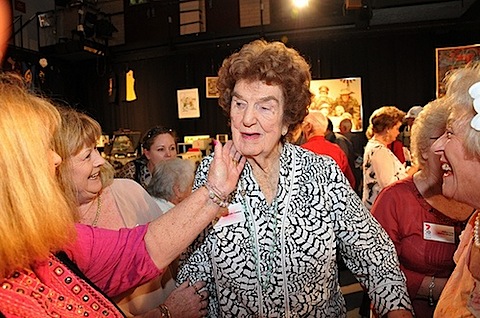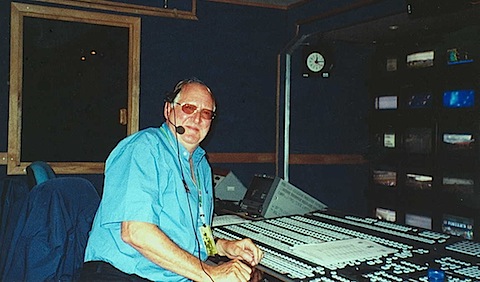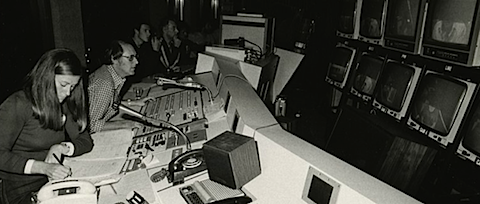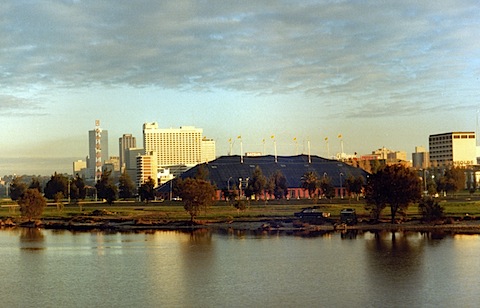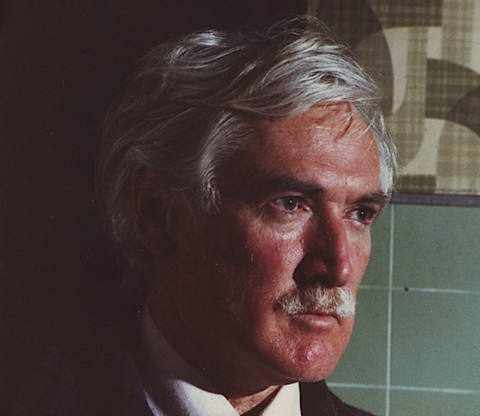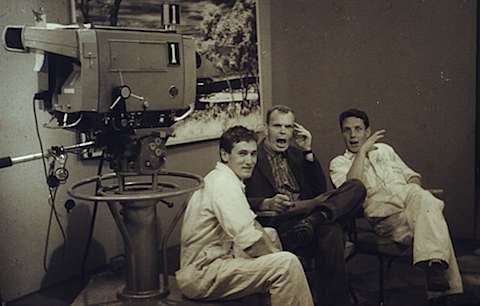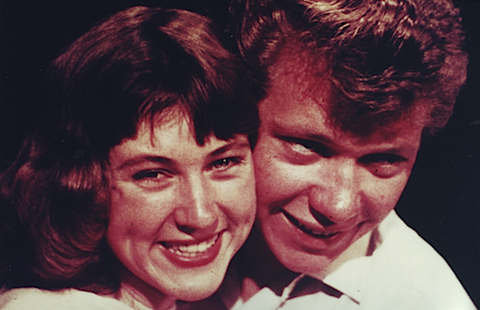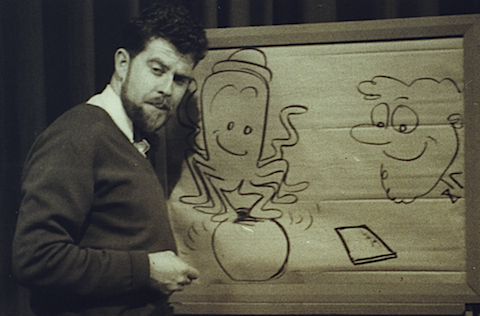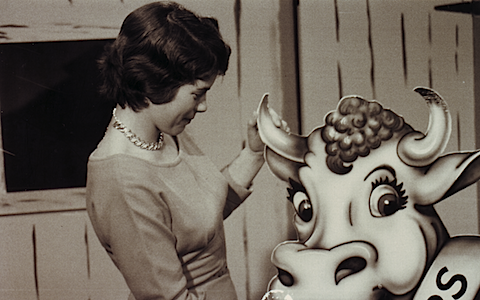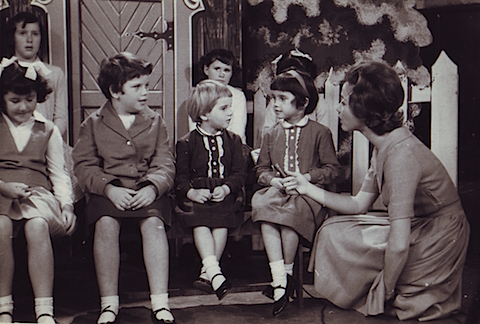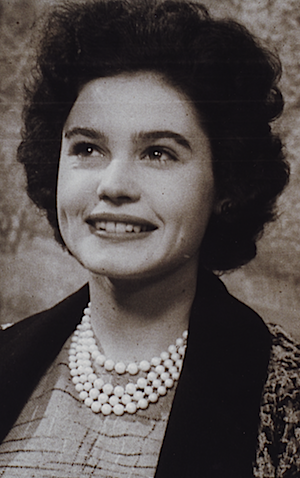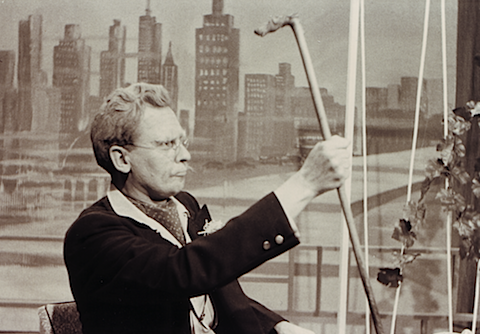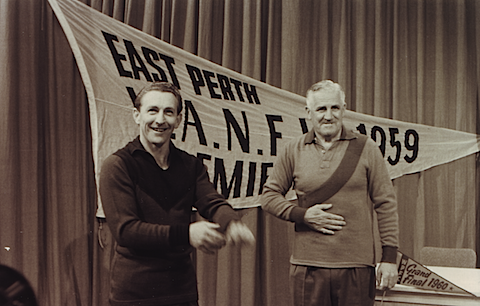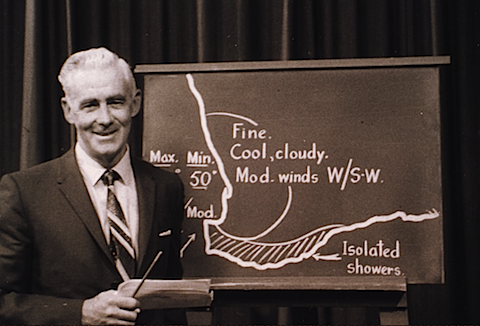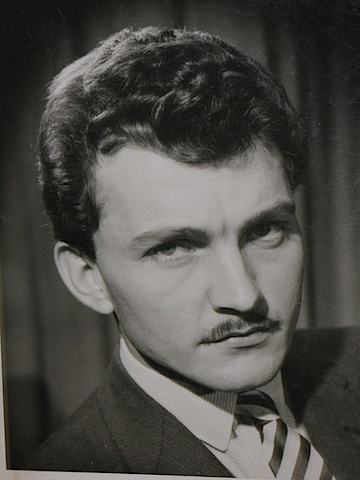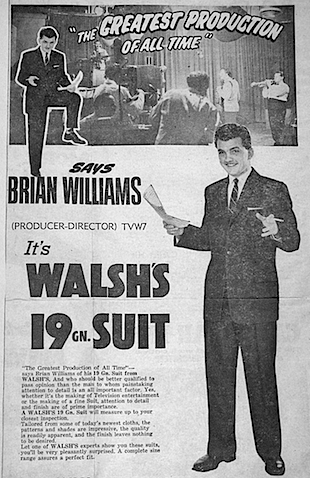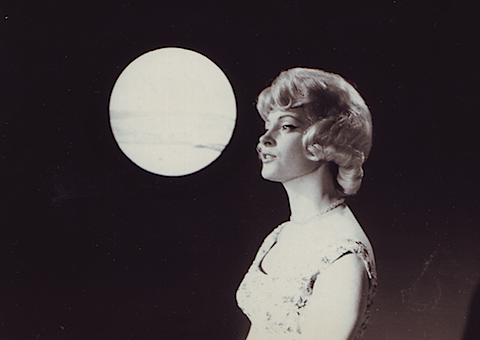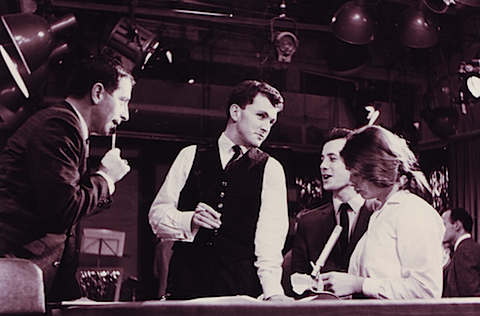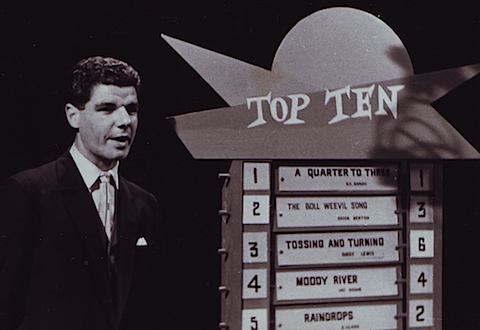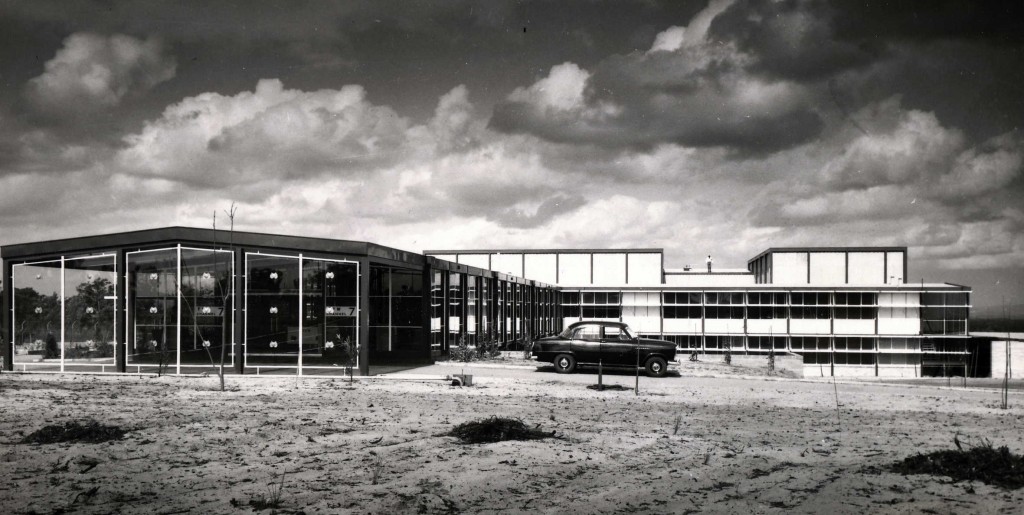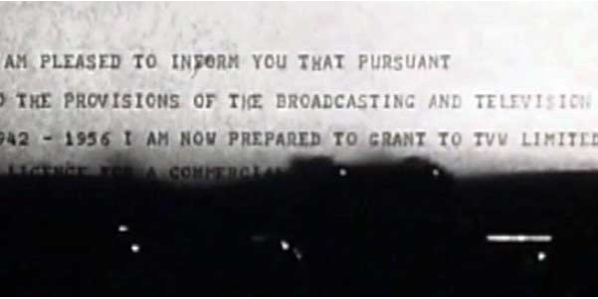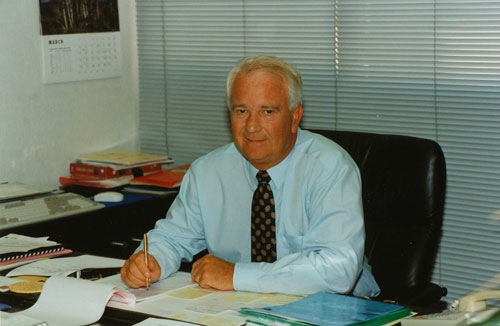On Wednesday, October 15, 1958 the Chairman of TVW Ltd announced some further of the details of the new TV station. Mr Friend said that as many as possible West Australians would be trained and employed; some selected staff would be sent to the eastern states the training. And in the Friday addition of the paper the Chairman stated that Perth was well cited for TV reception, and that it expected that 420,000 people would be able to get a first-class picture. The area covered would be from Yanchep to Mandurah and out to Wundowie in the hills. Fringe area reception would be as far north as Gin Gin and out to Clackline. Bunbury people with proper aerials would receive a good reception. Mr Friend also said that the TVW transmitter would be sited on Lawnbrook Road in Bickley.
Well, that was that. All the hard work had come to fruition.
It was also announced that the ABC’s new building in Adelaide Terrace had been started and that £680,000 had been spent up to date. The ABC’s TV officers and studio would be on Terrace Drive. The ANZ bank advertised in that day’s newspaper saying that people could start a TV savings account with the bank.
Amid much excitement, work on the new company would now start in earnest. It was announced that TVW 7 would be on the air in October 1959. There was much work to do. Plans to be finalised, land to be purchased, contracts and quotes for equipment to be received scrutinised and approved, and the work given out.
The main contract for TV equipment was given to the English Company PYE of Cambridge through Television Engineering Company of Melbourne at a cost of £270,000. They would supply the transmitters, studio equipment including cameras and support film and electronic equipment. Some of the relay link equipment was purchased from RCA of America.
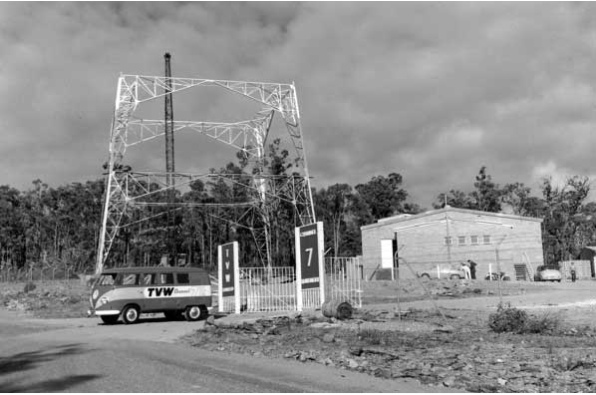
TVW Transmitter Tower and Transmitter Hall building under construction
In January 1959 work had started on the transmitter site at Bickley with the construction of the 475 foot high transmitting tower and building. The land purchases at Tuart Hill at the end of the roughly and quickly prepared Osborne Road off Flinders Street had been finalised. And the first clearing of the site east of the giant water tower commenced on April 4. Perth architect Bob Day of Hobbs, Winning and Leighton designed studio buildings and construction work on it now commenced.
The television equipment purchases in England were now well under way and some had been completed. The first £70,000 worth of equipment had been shipped and arrived at Fremantle on June 13 on board the P&O liner Oronsay, announced TV and Radio column writer Keith Flannigan. Some of the first news film shot of early work at Bickley and at Tuart Hill, and of the arrival and transportation of this English equipment was filmed by two young chaps using newly purchased 16 millimetre film cameras.
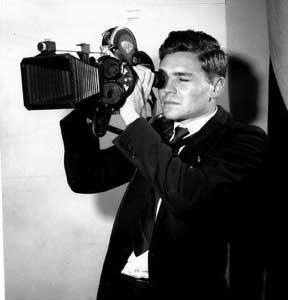
Keith ‘Digby’ Milner
Tom Hall and Digby Milner who were part of the West Australian photography staff took on this work; they would eventually join the staff of TVW as part of the TV newsroom.
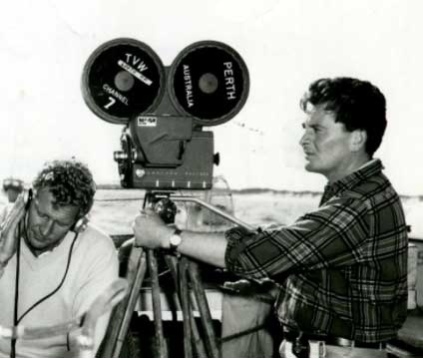
George Baker (Sound) and Tom Hall (Camera)
Flannigan also announced that this TV equipment would be unpacked over the weekend and the technicians will probably start installing it on Monday. He also wrote that. “West Australians who had been working overseas and had gone to the eastern states to work, are beginning to drift back here for the start of TV.” He also said. “Rolf Harris will be coming back from London to produce and entertain for TVW 7, and Lloyd Lawson will be returning from Melbourne to take over as program manager and technician Phil Salinger, who has been working with TCN 9 in Sydney, is already working at the Bickley transmitter site.”
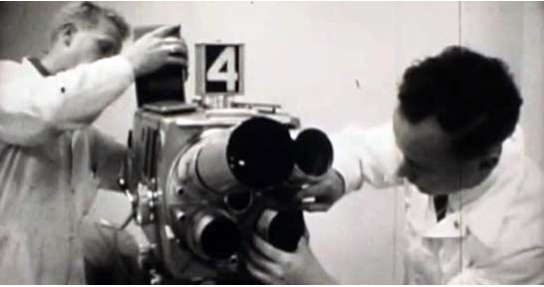
The West Australian announced that the technical team had been employed and all of 13 were now working unpacking the electronic equipment, and were working at 12 hour day. Graham Davey the chief engineer, who headed the team commenced installing the transmitters at Bickley, he was pictured in the paper, testing the just installed Sync Pulse Generator the heart of television electronic equipment of all TV stations. The transmitters were being tested too, into an initially a dummy load, but were expected to be ready for trade transmissions at the end of August.
For interest, a small picture of life and conditions in Perth in June 1959 showed that. Wild weather swept a wide area of southwest Western Australia. 56 mph gales lashed the metropolitan area. Farmers welcome the rain. The State Football Team was going to Melbourne for the big clash against Victoria; the team included a young John K. Watts. British stage star Sabrina was entertaining and His Majesties, and Jack Cassidy was putting the finishing touches to his new 16 foot skiff Evelyn VIII. Hillman cars were selling for £999 including tax. Radiograms were selling for £195.
Women’s shoes were selling for 59/11 and Paul Rigby Cartoons were selling for 10/6d at the Daily News Bookshop.
June 16 1959. A picture of Lloyd Lawson appeared in the West, and the accompanying small article Lloyd said that TVW will call for production staff this coming week. He also announced the daily evening TV news broadcast would commence at 6:45 p.m. And the first live TV programmes would be for children, panel shows, and programmes of women’s interests. There would be 56 TV programmes a week. The paper also noted that TVW Ltd shares were selling of 15 shillings and TVW options were 13 shillings. So I suspect the float was fully subscribed.
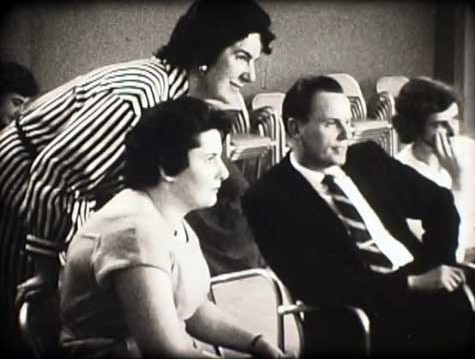
Beverly Gledhill, Coralie Condon, Lloyd Lawson and Penny Hoes
Auditioning process at Newspaper House
In a small piece in the West Australian of Wednesday, July 1 it was announced that TVW seven will hold their own auditions starting the following Monday. At this stage as there were no TV cameras, talent that showed promise would be call back later for a further on camera audition. Audition in the television must have been popular because by mid August in Keith Flannigan’s Radio and TV column it said that TVW7’s director Beverly Gledhill and producer Coralie Condon, and had sat through non-stop variety for a whole week. They had reviewed 300 acts of the actors, singers, instrumentalists, comedians, even a rope spinner and a performing dog.
There was also another note in the paper said that Musgrove’s Ltd was announcing the float for shares on a one-for-one basis at five shillings per share. This was to finance a venture into television sets sales, and service for the company. Musgrove’s had been in the music business in Perth for over 30 years.
It was also announced that country TV licensees would be released on the State by State basis and that the southwest of WA may have television as early as 1962. And in a meeting of about 60 country electrical retailers it was thought the television would reach about a 100 to 150 miles. Signals at Busselton would be good, Bunbury may have troubles because of the hills nearby and that signals could reach as far as Cunderdin and Merredin.
On Friday July 4 the West Australian announced that the TV tower at Bickley had reached its halfway building point. But three days later trouble struck. In a front-page article and pictures, it announced that four men in had fallen in a steel building cage from the 40 foot level and had been taken to Royal Perth hospital. It was announced later that none of the riggers had suffered any significant injuries. Mr Cruthers said there may be a delay in the starting of the trade transmissions scheduled for August because of the mishap. Damage had occurred because of the fall, at the top section of the half constructed mast, at the 220 foot level. The Melbourne firm that had fabricated the tower said that work on new steel parts had already been started. These would replace the damage sections, the delay may be only two weeks. At daylight survey was made yesterday however it revealed less damage than expected the West Australian announced on July 8.
On July 11 it was announcement that there would be five hours TV per day seven days a week. And Perth antennae firms were installing the first aerials around Perth and in the country, preparing for TVW7’s trade transmissions. Thinking was that viewers will be able to receive good pictures as far down as Busselton using 100 foot high telescopic antennae’s which would cost £148 it was estimated.
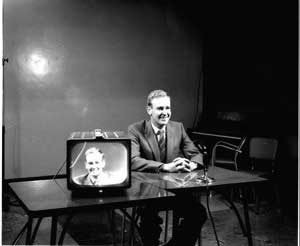
David Farr audition at Newspaper House
On August 4 the first on camera auditions commenced using a pretty primitive specially rigged camera at Newspaper House. Auditions were held for entertainers, singers and dancers, TV hosts and newsreaders. The other news that day included a photo taken at Perth airport showing Qantas Super Constellation aircraft arriving from London. Instead of landing at Darwin as usual, on its way to Sydney, it was diverted to Perth to do deliver £10,000 worth of TV equipment for the studios at Mount Yokine. It was noted that the freight charges for this equipment was £2875, quite a bill for those days. The aircraft was fitted with special extra freight doors and especially reinforced floor to take heavy loads. Parts included were, talkback equipment and parts for cameras and the control room. The photograph showed equipment being unloaded by forklift.
In the West Australian on Saturday, August 8 was a small article about a speech which had been delivered by TVW’s new advertising manager Brian Treasure. He was addressing the Liberal and Country Party State Women’s League Council. In his remarks to the group he said. “The first TV signals given by TVW will be on full power…the signals will ensure that the public would not be disappointed with poor reception.” He was obviously indicating that country people that were relatively close to the metropolitan area would also receive good television signals. And that more distant people with a good aerial would not be disadvantaged.
On August 12 another article appeared under the heading, Announcer. A 22-year-old radio announcer who has never seen TV would be WA’s first TV announcer. TVW7 program manager Lloyd Lawson announced last night that David Farr an announcer with 6PM-AM had been appointed to TVW. His appointment was made following the auditions last week. Two more appointments to the announcing staff would be made later on.
By Friday August 14, Keith Flannigan’s radio and television column had now a well-established readership. It announced that TVW will screen news films from all over the world in its quarter hour news service when it comes on air in October. A quote from Mr Cruthers said, that they had signed an agreement with CBS and ITN news services to receive an overseas service from America and England. News films would be flown in daily. TVW would also receive news from TV stations in other states from an exchange service. For state and local news TVW has two news cameraman and stringers in many big country areas. There was news about the tower construction. If the fine weather continued, work on the 475 foot tower at Bickley would be finalised next week, and finishing touches to the aerial and feeder lines would be then commenced.
August 15 saw the first of the telecine equipment installed and run in a side room at the Bickley transmitter. It was the first time that moving picture image were shown through a television close circuit system.
The first film was shown in the Telecine Section to the chairman and board of TVW Ltd. Mr C G Friend was pictured in the paper watched a documentary on this occasion. This equipment would show to air the film trade transmissions which it was hoped would start on August 31.
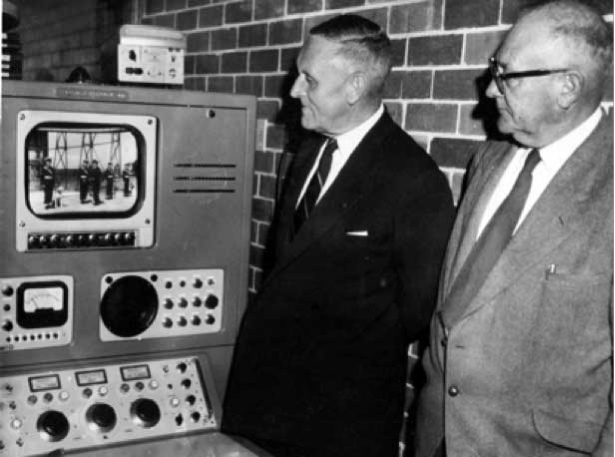
Mr C G Friend and fellow TVW Board member Mr M Fry see first TV images.
On August 17 a picture in the paper showed giant reels of cables which had been made in Germany had arrived and unloaded for the ABC’s transmitter tower. These thousand foot cables would feed the signal to the transmitter aerials on top of the tower from the transmitters housed in buildings below.
Two days later on Wednesday, August 19 the paper showed a picture of a man with his children looking at the blank television screen. The accompanying article noted that Mr J. A. Redmond was the first holder of the TV license in Western Australia. An Irish migrant, Mr Redmond recently visited overseas relatives with his Australian wife and the saw TV for the first time. He was so impressed that he bought a set immediately after returning, even though TV had not yet started, he paid his TV license in advance before seen a program. The article went on to say that TV licences could be secured from the GPO or any Post Offices’ within 50 miles of Perth. Beyond that distance a receipt may be issued for the £5 and the license would be sent by post.
In another small article a Federal Parliamentary Senator called for television films to be classified in the press and flashed on the screen before transmission. He suggested that G would be the general exhibition, A for adults only, and AO for programmes not to be shown on television before 8:30 in the evening. Interestingly there was a half page advertisement showing Graham Kennedy Melbourne TV entertainer wearing an advertising Glove Weave shirts!
On Friday August 21, Keith Flannigan in his TV and Radio column announced that the transmitter tower and been finished. He also announced that TVW7 now had three men who will be on camera regularly when TV starts on October 16. The latest appointment is ABC news man Geoff Walker who will read the news. The other two will be announcers, Phil Edgley a stage and radio actor and David Farr formerly from Radio 6 PM. He also noted that TVW7 studios at Mount Yokine had now found themselves to be in the Tuart Hill postal district.
In Queensland Brisbane’s new QTQ9 was ready and was on the air on August 16 1959, it was an American RCA packaged station. The two Adelaide stations NWS9 and ADS7 would come on air seven weeks later.
On Saturdays West of August 22, on the front page were to pictures taken with telephoto lenses of the toppled the TVW transmitter tower. The caption stated. “It’s There – 475’ High.” The last nut and bold were tightened on the last section of TVW’s transmitter tower which had started being constructed just over six months ago. The photo showed the Riggers had done their work. Soon the aerials themselves facing north, south, east and west would be added and coupled to the feeder cables which would run down the 500 odd feet to the transmitter hall below.
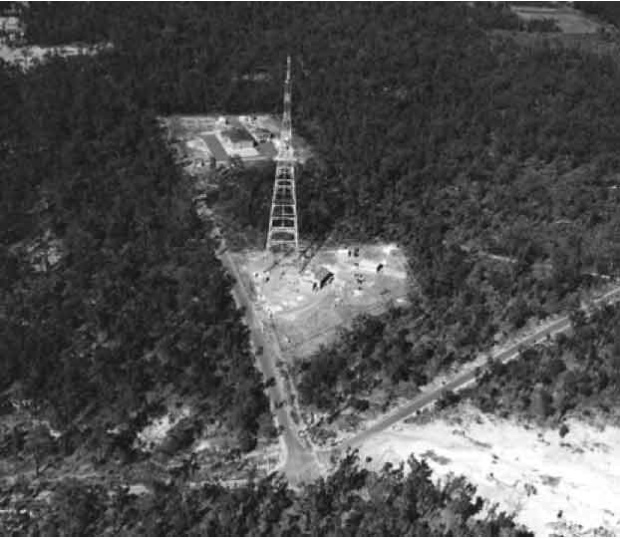
475 foot high transmitter tower completed. ABC TV Transmitter site at picture top.
Things were well underway now but in the next two months much work had to be done. The newly employed technicians both at Bickley and Tuart Hill were hard at work installing all the technical equipment that makes up the heart of the television system. It’s interesting to note and advertisement in the same paper inserted by Thorne Atlas a TV set manufacturing company.
Apart from extolling the virtues of their TV sets it listed the Do’s and Don’ts for TV watching. In another section of the same Saturday’s paper it announced the first annual report of TVW Ltd. The report for the period up to June 30 in which the directors noted covered the period of development and that no trading income had yet been earned. The company had made a loss of £39,405. It noted among other things that the land at Yokine Hill had been purchased. The 4 acres which contained the transmitter and buildings at Bickley had been purchased freehold. TVW was expected to open on October 16 1959 the report concluded.
On Monday, August 24 a full-page advertisement for Boans Ltd appeared in the West Australian. The banner headline announced Boans TV show today, in the Fashion Hall on the first floor. 12 trusted names in top television sets would be on show. The advertisement went on to indicate that Boans would offer you WA’s best TV deal, and that a free information booklet was available to help you make your choice.
The advertisement also announced that the official opening of their TV Show would be at 12:30 today and it would be opened by the Chairman of Directors of TVW Mr C G Friend. The TV show would continue till September 5.
In later pages in the same paper, a full-page Nicholson’s TV advertisement appeared. It suggested that they would deliver fair trading as they had done the last 70 years, and they were not flyby nights, and could supply high-quality television, and quality after sales service. The paper also had an advertisement for PYE television sets and service. The illustration showed a studio television camera elevated on a camera crane.
On Tuesday morning’s paper of August 25 on page two, a paragraph heading said. Monday TV-Outlook Fine. The sub heading said. “The prospect of TVW7 beginning trade transmission on Monday (next) is like the weather, fine. The Weather Bureau predicts fine weather until Wednesday, that should give TVW technicians time to hoist the 525 foot feeder cables to the top of the television tower at Bickley.” The article went on to say that once the cables are in place they will not be a mercy to the weather. In yesterday’s warm weather the last of the 24 aerials, six on each face were clamped to the 70 foot top section of the tower today. Graham Davey TVW chief engineer and his team of technicians will now hoist the feeder cable. Moisture will affect the £3000 feeder cables. When they are fitted, specially dried air will be pumped through the feeder’s aluminium casings. As the cable goes up they will be pulled through a box which will straighten out the cable. Both must be the same length to within 1/16 of an inch. The article continued. “An engineer will arrive by plane today with a Diagraph which will measure the cables electrically. When everything is fitted an engineer for the Broadcasting Control Board will check to see if the transmitter meets the prescribed standards and TVW7 will be ready to go on air.”
On page seven was a further announcement. “TV Sweeps the City.” One of Perth’s greatest sprees got underway today when wholesalers delivered 2000-2500 TV sets to city dealings, the paper announced. It also reported that. “At lunch hour exhibition in a city store, 500 jostled shoulder to shoulder to see a variety of TV sets. A closed-circuit chain gave an idea of what TV would be like.” On Friday, August 28 there was a picture showing the cables leading up the tower.
In the classifieds there was a smaller ad saying. “John Allen’s requires a TV salesman with own car. We offer a large incentive scheme.”
The following day in a small paragraph on page one it said that there would be a 46 page supplement about the introduction of trade transmissions and that TVW would switch on to full power on Monday, August 31. In the same Saturday paper. “Hotels Rushed TV Sets.” The article said that city and suburban hotels had been rushing to install TV’s in bars and lounges in readiness for the start of trade transmissions on Monday. It went on to say, some other hotels will wait till they could accurately gauge the demands of patrons. Some publicans predicted of falling off of trade and some others said there would be no great attraction expected.
The following Monday August 31, the West Australian showed on page one under the heading. “Test shows a wide TV coverage in WA.” The article said, the first preliminary transmitter test had been made about 5 p.m. on Saturday afternoon and within five minutes the first viewer reports came in, first from a viewer at Lesmurdie. Numerous reports from the metro area were then also quickly received. Further initial unofficial tests by TVW over the weekend indicated a good coverage could be expected. At Bruce Rock 140 miles away, at Kellerberrin 100 miles away, and that Bunbury 92 miles away a good signal strength had been received and reported in by viewers.
The chief engineer Graham Davey had made the tests to make sure that everything was right to start the trade transmissions at 11 a.m. on the Monday August the 31. TVW general manager Mr J Cruthers tuned in at his Como home and watch the first test transmission, a TV test greyscale came on the air with music. He report of the happening to the Bickley transmitter, he said that tests results at his home were good right from the start. On Sunday TV tests were on again from 1 to 2:30 pm, and further technical tests and field strength’s were tested and nearby areas.
Today, the Monday paper announced, WA would feel the first big impact of television. More than 5000 television sets worth over £1,000,000 will be on sale as TVW started its trade transmissions for the next six weeks. Most transmissions would be off test patterns and commercial films. The program for today would be from 11 am to noon with test pattern, from 12 till 2 pm, films. Test flight 263, the History of Big Ben, Barrier Reef Fishermen, and Ice Carnival would be shown.
The excitement over television was further carried on with the 46 page TV supplement, published to coincide with the start of trade transmissions.
The West Australian offered an editorial comment about the commencement of TV in WA. It noted the profound changes TV would make to everyone’s lives. It also told of the opportunity for local talent and of commercial enterprise. It also said that a lot of rot had been talked about TV’s power to pervert young minds and dull were sensors of the old, and concluded by saying. “We should remember that when all is boiled down TV will be as good or bad as we make it.”
In the TV supplement advertisements appeared for nearly every electrical retailer in Perth, both large and small. The editorial content too was most comprehensive and included many articles, from what TV set to buy, viewing reception areas, technical facts, viewing habits in other states and program guides for the next few weeks.
Channel 7 General Manager Jim Cruthers contributed an article on the introduction of television, announcing that. “Today begins the new year of entertainment in Western Australia.” Other contributors included the background story of the chief engineer Graham Davy. Program manager Lloyd Lawson and news editor Darcy Farrell also told of their history and plans for the future. The Postmaster General Mr C W Davidson offered congratulations to the new TV Company, TVW Channel 7.
Another supplement article indicated that Australians had so far outlaid over £113,000,000 in buying new TV’s, the article suggested that taking £190 as an average cost of a television set, and almost 600,000 television sets would have been sold. To the end of March 1959, 52% per cent of households in Sydney had television, and in Melbourne the percentage rose to 58%. Three out of every four televisions were of the 21 inch size. The article also said that there were now 16 TV stations in Australia. 10 Commercial and 6 National. It also noted that the Perth ABC TV would be on the air by next March or April next year. Another interesting statistics noted that 11 miles of film would be used each week in bringing TV programs to the screen.
Many television companies and retailers advertise strongly in the supplement. The biggest probably was Phillips, they had four full pages. Other companies such as Healing, PYE, Simpson, HMV, AWA, Pope and Admiral all contributed with large advertisements. Insurance against TV faults reared its ugly head; £10 a year would cover you for a service contract. There was a comprehensive buyer’s guide including prices for all makes of TV sets that would be available for sale.
It was like the floodgates being opened, television was underway, and it would change our lives forever.
In the West Australian September 4 it was noted that television was likely to be on full power for trade transmissions today. Both transmitters would be feeding power into the aerial at Bickley. The PMG announced that so far 495 TV licences had been issued, more than 100 for each of the last two days. Two days later TVW 7’s first night transmissions started. The first evening transmissions included The Cisco Kid, up till now only documentary programs had been shown. Two days later on Thursday September the 17, programs were transmitted to air from the Tuart Hill studios. The microwave link system to the transmitter had been established. The evening’s trade transmission will be screened at the studio and flashed by microwave link to the transmitter at Bickley the newspaper announced.
The West Australian’s press launch the Hiawatha a trial was held with television set on board. Good pictures where received on the Swan River except when the vessel turned. In Blackwall reach ghosting had affected the picture, but at Rottnest the picture came in very well. I suspect those on board had a pleasant day during the tests.
On Monday, September 21 the paper announced that discounting had started, it said that top TV dealers would act on cut rates for TV sets. Five of Perth biggest dealers said yesterday that they would band together to cut down on price cutting. This move came after a published report that TV discounts had been offered to purchases of up to 12% to 15% on certain makes of television.
They claimed certain wholesalers were selling directly to the public and the big dealers were forced to follow suit. The following day it was announced that TV licences in Perth had exceeded 2000. By the Wednesday it was announced that the two TV dealers W. J. Lucas and Ron Shaw who had been disciplined for alleged breaches of the Television Retailers Association rules had been reinstated, and would again be supplied by wholesalers. It was also interesting to see a big Rothmans cigarette advertisement which depicted couples smoking and showed a television camera in the background of the picture.
As the third week of trade transmissions concluded the Postmaster General’s representative said that 7702 TV license had now been issued. Further TV programs had been shown during this period included a short cartoon feature called Crusader Rabbit, and regular shows such as Casey Jones, Bold Adventure, and Wings to Alaska had also been shown.
By the end of September the News, Graphic and Production departments had moved from their temporary offices in St Georges Terrace to the newly completed studio at Tuart Hill. By Sept 25 full-time trade transmissions were commenced, 1 till 4 test pattern and music, 6:45 to 7 pm test pattern and music, then from 7:00 film programs till 8:45.
By September 29 the studio was in there solo role, TV broadcasting. At one o’clock the studio’s clocks were set four 5:30 p.m. and programs were run to time in rehearsals some complete with commercial content. Children’s programs including Children’s Channel 7 were rehearsed. I Love Lucy, Maverick, Highway Patrol and many other programs scheduled for the first week were also run.
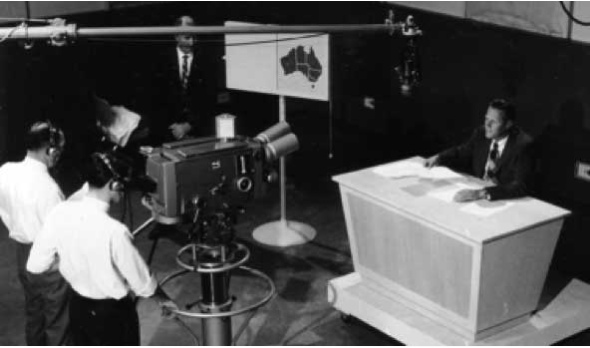
TVW 7 newsreader Geoff Walker rehearses the evening news broadcast
Left to right: Jim Healy floor manager, Richard Ashton camera and at the back of the picture is Vin Walsh, the weatherman.
At 6:15 studio time Geoff Walker read the evening news and the weather was also presented by Vin Walsh, a retired met officer from the RAAF. He had he drew up the weatherboards from detail supplied from the Bureau of Meteorology. The purpose of the real-time rehearsals was to exercise and gain experience for the studio, presentation and production people, they were rehearsals for the real thing. All following week the studio would rehearse the full program’s daily including the live content. The opening of the station was two and a half weeks away.
In the Weekend Mail newspaper of September 12 much of the editorial was devoted to television. The paper featured many items and articles about programs and station personalities. They also included many interesting paragraphs on the backgrounds of senior staff members. Storylines were often printed about program content, news and children’s programs, and items about Wirley Birds, Mickey Mouse Club, Rin Tin Tin, and some to become favourite Efrim Zimbalist junior and Roger Smith starring in 77 Sunset Strip. Pretty dancer Judy Schonnell, soon to be seen on TVW’s variety programme Spotlight, was photographed and featured sitting inside a large television set.
The Weekend Mail also produced TV guide, listing night by night, whole week’s television programs. There was also a supplement in the West, again supporting the opening of the station. In his welcome editorial Mr Cruthers commented about the many advantages of television to the community. He appreciated the strong support that had been received from Western Australians. He said we had been able to build a TV station which at the present time is as modern as any other states of comparable size in Australia. The quality of the pictures ranks with the best in the world. In commenting about opening the station on a Friday he said, that the Board of TVW were not superstitious, but simply because Friday it was felt, would make a better opening night. Mr Cruthers went on to say, TV may be a novelty here, but in other parts of the world it is simply a way of life. In the United States I saw television in every hotel room, in bars and clubs, many homes had two sets he said. Already in Sydney and Melbourne 60% of all homes had a television set. In conclusion he said we sincerely hope you enjoy TV and we at TVW will seek to bring you our viewers the very best in the world’s entertainment.
The Opening.
The two studio doors opened outwards and the cool night air rushed in. Trumpeters from the Fifth Military District took up their places of each side of the doors. Into the studio now came the general manager of TVW Jim Cruthers and the Chairman of the Board Mr C G Friend. They took their places at the back of the four chairs in the upstaging area of the quite small studio 2. We had rehearsed this opening a number of times so our positions and shots were well practised. But now it was the real thing, rehearsals were over.
Penny Hoes, director’s assistant in the Studio 2 control room voice could be heard in our earphones. We also recognise the familiar voice of Beverly Gledhill our TV director for the opening. The technical director was John O’Callohan, he was in the control room too, he was talking to the camera control unit operator’s, making last minute nervous corrections, they were all downstairs in the Master Control area. You could sense a few nerves were showing by the last minute instructions which could be heard for all those who had the earphones on in the studio. They include TVW’s floor managers Brian Williams and Frank Evans. Steve Lumsdaine who was on the microphone boom, he was another experienced chap from Sydney. There was a voice in my other ear, it was my camera controller Paul Kinna, he whispered. “Good luck mate.” I couldn’t reply, but gave the camera a little nod up and down on the pan and tilt head to say thanks.
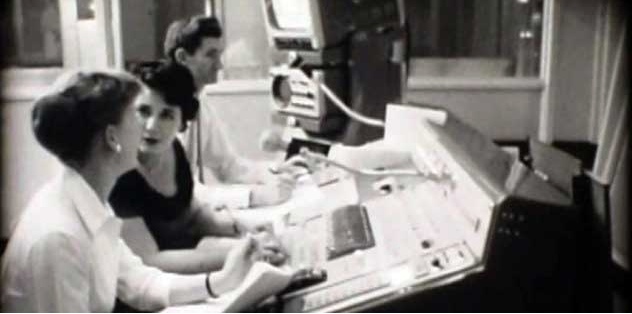
John O’Callohan, Beverly Gledhill and Penny Hoes in the Studio 2 Control Room
Penny Hoes announced in our earphones. “Standby on the floor.” I looked across at Gordon McColl who was on camera two on my left, he seemed okay, he was also an experienced cameraman and had done this all before, as he was also one of the chaps from ATN 7 in Sydney. I looked back into my viewfinder as Bev Gledhill said. “15 seconds to air, focus up camera one and two.” On those early cameras you couldn’t keep them in sharp focus from fear of what was known as an image stick, an image retention in the taking tube. So to prevent this happening one always kept their camera either defocused or moving slowly backwards and forwards, I quickly focused up, my shot showed the opening Studio 2 doors at which, in the next few seconds the black Daimler of the Governor would appear.
The seconds ticked away. Finally Bev said. “Stand by two.” My camera came to rest and I checked focus again. “Dissolved to camera two.” and the little red light appeared in my viewfinder indicating that my camera was on the air. The Daimler doors opened and the Governor appeared and walked with his ADC to the studio door.
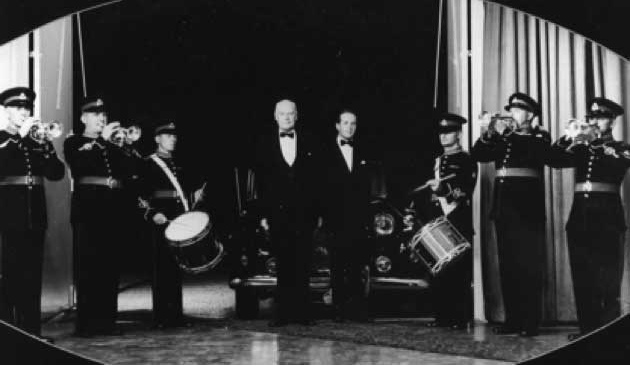
Studio 2 doors open to reveal the Governor Sir Charles Gairdner his ADC and members of the 5th Military District Band with the fanfare.
The trumpeters from the Fifth Military District Band played their Fanfare followed by the recording of God Save The Queen. Everyone was at attention. At the end the Governor and his ADC then moved towards Mr Friend and Mr Cruthers. Beverly dissolved to camera one, Gordon was the camera for the shake hands and he followed them to the chairs. Mine was the cut away of the seating. Gordon then had the close up on Mr Cruthers. I repositioned for Mr Friend’s medium close-up.
Bev took Gordon’s camera shot too air, and to the many thousands of people watching their new TVs in their homes, no doubt with many friends who had dropped in to see the TV opening. Many others were watching Gordon’s picture of the opening in shop windows of electrical retailers all throughout the Perth area, who had kept their TVs on in the display windows for the opening, with little loudspeakers playing the sound out into the crowd street. Many sitting on chairs the blankets, such as was the enthusiasm for this new medium TV. Brian “qued” Mr Cruthers to camera and then dropped his hand indicating for him to commence.
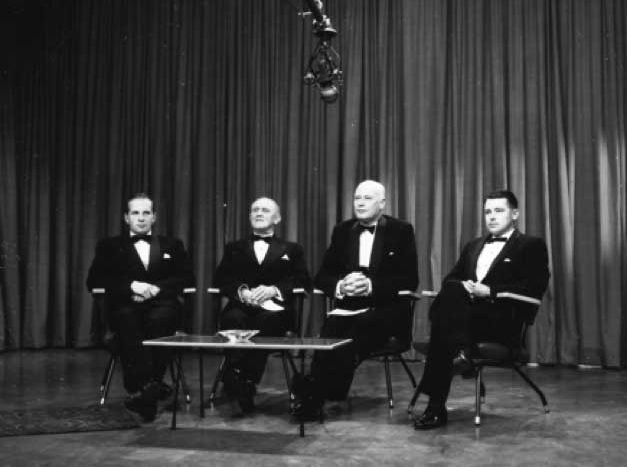
The Governor announces “I declare TV officially open.”
Jim Cruthers said. “Good evening, on behalf of all of us here at TVW I am very pleased, and I must admit a little bit relieved to say at long last, welcome to television in Western Australia.”
He continued. “Because most of you haven’t seen regular TV before our aim tonight is to show you a selection of the type of programs we will present to you in the future. Some from overseas, some local. For instance, later on in the evening our staff will present a live variety show, written and produced especially for opening night, and there will be some news and weather information prepared and presented locally.”
Mr Cruthers went on to talk of the overseas programs that would be shown. Firstly you will meet the Beaver he said, then, Father Knows Best, Sea Hunt, Perry Mason, and Marshall Matt Dillon from Dodge City in a program called Gunsmoke. There’s a further 197 episodes of Gunsmoke to follow, he said.
Jim Cruthers then said. “Now I’d like you to meet Chairman of Directors of TVW Mr C G Friend who will introduce his Excellency the Governor Lieutenant-General Sir Charles Gairdner.”
Bev in the control room cut to my camera, a close up of Mr Friend. Mr Friend said. “On behalf of the Board of TVW can I say how much we appreciate and recognise having his Excellency with us this evening.” Mr Friend went on to say how pleased and proud he was to see television here in Western Australia. It had been a long and highly involved process, and that he was also proud that TVW Ltd was truly a Western Australian company with over 2000 shareholders 99% of which were Western Australia’s. Mr Friend said that the General Manager and most of the staff were Western Australia’s. He then went on to introduce his Excellency Sir Charles Gairdner and invited him to officially open television in Western Australia.
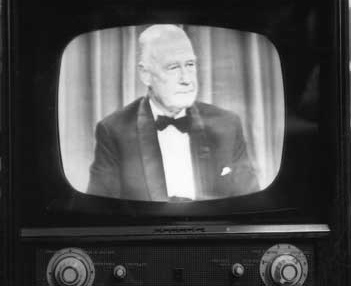
Photographed off air TV set showing the Governor opening speech
Gordon’s close-up was of the Governor. Bev in the control room cut to camera two. The Governor said. “Tonight is a very important one for us in our State, certainly a milestone in our progress which would have profound effects on the lives of all of us.” The Governor went on to say that some people said that television would pervert the mines of the young and dull the mines of the not so young. But he didn’t count on himself as one of those.
He went on to say that television would enhance the appreciation of sport, its appreciation of world figures and happenings, and, it would increase our knowledge of world events. He also said that it would also be a helpful relaxation in the home. The Governor then declared television officially open in Western Australia.
It was all go, we are off and racing.
On page one of Saturday mornings west of October 17 1959 one of the main paragraphs read. “TV plays to thousands to its biggest audience yet.” The paper went on to say that crowds blocked foot paths for the gala night, free TV shows in shop windows, kids in pyjamas and dressing gowns in the main city block, the paper continued.
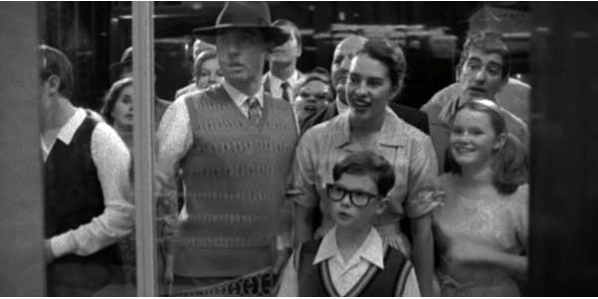
There were now 3387 licensed TV homes. However it was estimated that each household had the least 12 to 15 watching the opening this would amount to some 40,000 viewers.
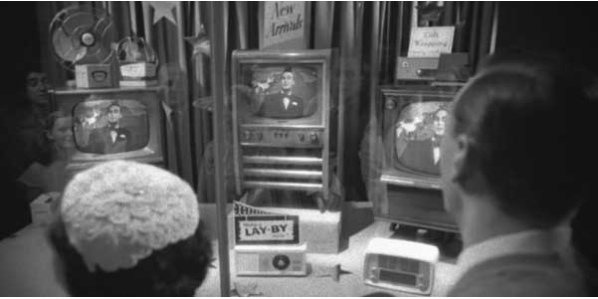
Newsreader Geoff Walker had come on to introduce a film history of TVW from the signing of the licence agreement, the building, the auditions and final rehearsals, up to the opening, the newspaper reported. A period of three years in one month since TV had started in Australia on September 16, 1956. There was a festive atmosphere at Tuart Hill the paper said. 150 guests in formal dress were in Studio 1 to watch the opening on 11 TV sets placed around the walls. Telegrams had been received from all parts of the world conveying best wishes for the opening. Local news was televised following the opening program. There were flashbacks of local stories which included one in witch a young boy called Graeme Davies of Mandurah who had accidentally fallen down the bore hole and who was successfully rescued in January 1957.
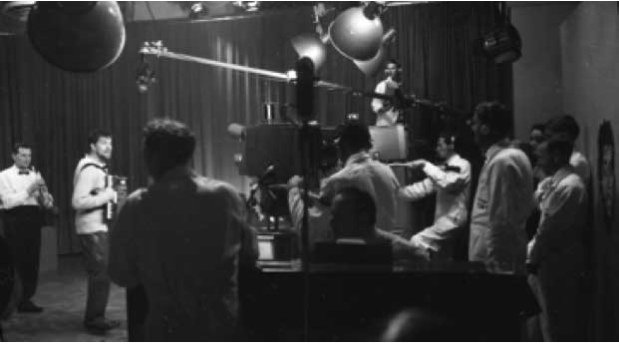
Rolf Harris sings and plays his accordion during the opening variety show “Spotlight.” I’m on camera 1 and Gordon McColl to my right on camera 2, Steve Lumsdaine on boom microphone, Harry Bluck on piano in fore-ground, Floor manager Frank Evans behind Gordon, Properties man Bill Smeed behind.
A variety show called “Spotlight” introduced by Phillip Edgley supported by actress Colleen Clifford was telecast. The show featured songs and dances from Diana Briggs, Edgley and Brian Card. Harry Bluck and his orchestra accompany them. Local singer Maureen Coreless entertained as well. Rolf Harris sang and played his accordion too. About the late news segment the paper said. “TVW reported just how Perth had received television with a newsreel coverage filmed while the studio was on air.” The evening’s program finished at midnight with the televising of the Perry Mason program.
Yes, we were certainly all off and racing, the whole 90 odd of us TVW Channel 7 people! Tomorrow, Saturday it was on again, as well as live news and film television programs, Syd Donovan and Frank Bird would present a live sports program called “Sport at Seven.” The first program would feature interviews of East Perth’s football captain Jack Sheedy as well as other sports results and interviews. Jack became quite a regular TV guest into future sports programs.
Then on to the first week. As well as nightly news broadcasts at 6:45 pm, television would show, on Monday nights a half hour live show called “Relax with Rolf.” It featured a pretty young mystery guest called Astrid Spargo. Rolf invented his wabble board and in Studio 2, and we sound recorded his, to become famous song “Tie Me Kangaroo Down Sport.” Live children’s program Children’s Channel 7 on Tuesdays and Thursdays at 5:30 pm the program would feature Rolf Harris and many of his drawings, paintings and puppet characters one included was Oliver Polip the Octopus. There would be many guests on all sorts of subjects including Pet Care with Pat Thomas, Vincent’s Seventti talking and showing animals. There were also many hobbies segments hosted by Len McKenna, and graphically illustrated children’s stories, many illustrated by Rolf himself. The weekly variety show “Spotlight” would be on air live on Thursday nights at 10 o’clock.
Television was on the air in Western Australia. TVW had spent £600,000 getting it there. Now the Board and the shareholders were hoping to get some of that back!
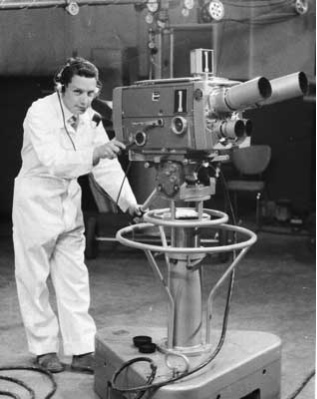
Richard Ashton 1959
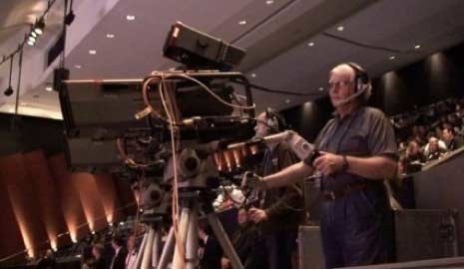
Richard Ashton 50 years later
